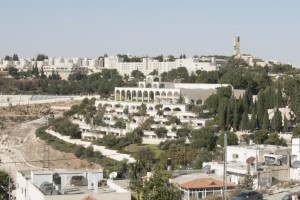
Participation in the BYU Jerusalem Center program has declined. Jerusalem Center directors believe this is because of the missionary age change and students’ fear of danger overseas.
President Thomas S. Monson had announced the mission age change during the October 2012 General Conference, resulting in a huge influx in missionary numbers. The number of students applying to the Jerusalem program decreased the following spring. Sixty students are currently signed for the new spring/summer semester, and only 40 are signed up for Fall 2015.
“The semester immediately following the announcement wasn’t affected, but after that the numbers dropped,” said Debra Petersen, program administrator for the Jerusalem Center. “We normally have around 80 students during the spring/summer term, but in 2013 we only had 60.”
The change is especially significant because in 2011 and 2012, the Jerusalem Center had record applicants and had to turn students away. The Jerusalem Center’s enrollment allowance is currently at half capacity — no more than 82 students at a time. The First Presidency mandated this when the center reopened in 2007, because a smaller group would be easier to evacuate in case of emergency.
The Kennedy Center is home to the International Study Program Office. All study abroad programs go through this office except for the Jerusalem program. The Kennedy Center also saw a major decline in applicants after the Church’s announcement.
James Kearl, assistant to the university president for the BYU Jerusalem Center, listed other reasons for the decline in applicants.
First, he said, the Jerusalem program and other study abroad programs are based in the liberal arts. In recent years there has been less interest in liberal arts.
Second, the missionary age change may have caused a decline as the number of female applications to the Jerusalem program dropped 75 percent after the age change announcement.
“It is unclear if returned sister missionaries will go to the Center,” Kearl said. “There may be less interest now that the foreign experience women seek out could be filled by their missions.”
The Jerusalem Center is waiting to see if numbers rise after the “mission bubble” pops. Since the announcement was more than two years ago, the Jerusalem Center directors expect to see results within a year.
Finally, Kearl said, the Middle East looks like a scary place.
“The risk issue should not be an issue,” Kearl said. “We have acceptable bounds that are manageable, or we wouldn’t have students coming.”
There has been a lot of media attention in the area because of political violence, but Kearl said students are always safe. “The violence in the region is higher, but where we travel, the violence is lower,” he said.
The Jerusalem Center is located in one of the safest places in Israel, Kearl said. Jerusalem is considered by all the Abrahamic faiths — Islam, Christianity and Judaism — to be a holy city, so these groups would not want to destroy it. The center is also located in East Jerusalem, the Palestinian area of the city, and is situated one-half mile away from Islam’s third-holiest shrine, the Dome of the Rock. An attack on this area would be illogical, Kearl said. Even if West Jerusalem was to receive fire, the east side is five miles away and clear from danger.
If the risk does get too high, the university will pull students out of the area. Kearl said students were pulled out of the center in 2000 because the conflict of the Second Intifada war made travel difficult, not because students were in physical danger.
“The students there are perfectly safe,” said Kristi Sobeck, a former BYU student who completed a semester in Jerusalem. “One thing I know for sure is that they will take the students out of the Center the second they feel that they need to. They’ve closed the center before and will again if they need to. The safety of the students is the main concern, and the faculty and security guards are fully focused on that.”
The Jerusalem Center has measures in place in case of danger. During the Gaza War in the summer of 2014, rockets flew between Israel and the Hamas government of the Gaza Strip. The Israeli-American defense tool Iron Dome shot down nearly all dangerous rockets before they hit Israel. The center remained open, and none of the students was harmed. Two bomb shelters are located at the center and were utilized if attacks got too close.
Kearl encouraged students thinking about studying in Jerusalem for a semester to sign up. He said the Jerusalem Center is “the best thing BYU does” — an ideal integration of religious, secular and community learning. The students take courses such as Old and New Testament, ancient area history, modern history from a Jewish and Palestinian perspective and language study of Arabic or Hebrew.
Students participate in local service activities and visit the Jordan River, the Old City of Jerusalem, Turkey, ancient ruins, Jordan and the Sea of Galilee. Each Monday students go on a field trip.
“My semester in Jerusalem was life changing and worth every penny,” Sobeck said. “I don’t think anyone should be afraid of going.“




